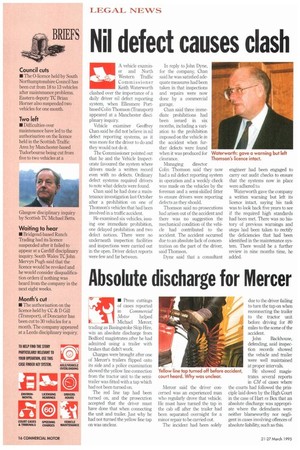Nil defect causes clash
Page 18

If you've noticed an error in this article please click here to report it so we can fix it.
A vehicle examiner and North Western Traffic Commissioner Keith Waterworth clashed over the importance of a daily driver nil defect reporting system, when Ellesmere Portbased Colin Thomson (Transport) appeared at a Manchester disciplinary inquiry.
Vehicle examiner Geoffrey Chan said he did not believe in nil defect reporting systems, as it was more for the driver to do and they would not do it.
The Commissioner pointed out that he and the Vehicle Inspectorate favoured the system where drivers made a written record even with no defects. Ordinary defect systems required drivers to note what defects were found.
Chan said he had done a maintenance investigation last October after a prohibition on one of Thomson's vehicles that had been involved in a traffic accident.
He examined six vehicles, issuing one immediate prohibition, one delayed prohibition and two defect notices. There were no underneath inspection facilities and inspections were carried out in the open. Driver defect reports were few and far between. In reply to John Dyne, for the company, Chan said he was satisfied adequate measures had been taken in that inspections and repairs were now done by a commercial garage.
Chan said three immediate prohibitions had been issued in six months, including a variation to the prohibition imposed on the vehicle in the accident when further defects were found when it was produced for clearance.
Managing director Colin Thomson said they now had a nil defect reporting system in operation and a weekly check was made on the vehicles by the foreman and a semi-skilled fitter to ensure drivers were reporting defects as they should.
Thomson said no prosecutions had arisen out of the accident and there was no suggestion the mechanical condition of the vehicle had contributed to the accident. The accident occurred due to an absolute lack of concentration on the part of the driver, said Thomson.
Dyne said that a consultant
engineer had been engaged to can-y out audit checks to ensure that the systems now in place were adhered to.
Waterworth gave the company a written warning but left its licence intact, saying his task was to look back five years to see if the required high standards had been met. There was no history of previous warnings and steps had been taken to rectify the deficiencies that had been identified in the maintenance system. There would be a further review in nine months time, he added.
















































































































